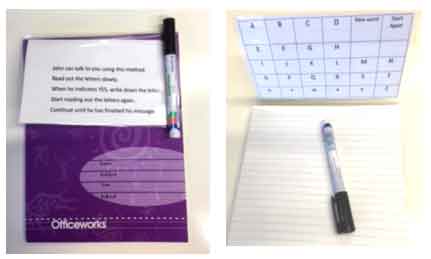
We often received panicked calls when communication devices or systems need to be repaired, or cannot be used for one reason or another. It might be because it's bucketing down with rain, or the person is in the bath, or in the middle of a physio exercise.
We are strong proponents of low tech communication system or even strategies requiring no aid at all!
Essentially there should be multiple options for communicating so that all eventualities are covered.
Described here is a technique for communication, to construct a message without the need for a communication device. This is called an ‘unaided’ strategy.
This technique might be used for a person who is unable to speak, and also cannot point to letters on an alphabet chart due for physical and/or vision reasons.
The communication partner may be a friend, staff member, family member or other person who can take the time to learn this method, and use it with the communicator.
The Communication Partner slowly reads out the items on an alphabet chart, until the person indicates ‘yes’.
The alphabet chart is indeed an aid, but this is really a prompt for the communication partner. Once the technique is familiar sometimes this can be discarded or maintained for new communication partners.
For a person who cannot see the alphabet chart, there will be reliance on the spoken prompts.
Usually the alphabet chart would be set up in alphabetical order.
Establish how the person will be indicating “yes”, by asking the person to show you how they will indicate. This may be verbally, or with a physical gesture, for example a finger tap, small hand wave, or head nod, or any other action the person can provide independently and easily so that it is non-fatiguing.
It is useful to have an alphabet chart in front of you, along with some way to write down the letters indicated.
This could be a simple writing pad, whiteboard or exercise book.
It is also useful to have a summary of how to use this system written in an obvious place (e.g. on the back of the alphabet card) so that anyone can quickly learned how to use it.
TO START:
If relying completely on voice, be close enough to the person so that they can clearly hear the auditory prompts.
Start speaking the auditory prompts slowly, providing enough time for the person to indicate “yes”
This is simply a matter of reading out the letters, slowly enough to permit time for a response.
SPEAK: A ……B……….C………D………..E…..
When the person communicating indicates “yes”, stop and repeat the letter for their confirmation.
Write down the letter they have indicated. This can be on a notepad, exercise book or small white board.
Start the process again.
It is useful to write down the letters, and re-cap them as required. As the process can be quite slow it is helpful to keep track of the word or sentence in this way.
DESIGNING THE ALPHABET CHART:
It can be useful in designing the alphabet layout to also include some commands such as
‘space”, or “new word”, “start again”, “finished”.
Depending on the individual, it may be possible to cluster letters to speed up the process, for example instead of speaking each letter individually, say “A to H” “I to N” and so on.
Below is an example of laying out the alphabet chart and an exercise book for recording. If the person is not using the vision to look at the chart, this is for the communication partner’s benefit.

by Tracey Bode
 We often received panicked calls when communication devices or systems need to be repaired, or cannot be used for one reason or another. It might be because it's bucketing down with rain, or the person is in the bath, or in the middle of a physio exercise.
We often received panicked calls when communication devices or systems need to be repaired, or cannot be used for one reason or another. It might be because it's bucketing down with rain, or the person is in the bath, or in the middle of a physio exercise.
